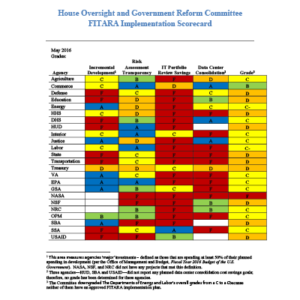
This coming April, government agencies will once again report on how well they’re complying with the Federal Information Technology Acquisition Reform Act (FITARA). Unfortunately, last year’s report card was littered with failing grades, which means there’s probably not enough emphasis in government on monitoring IT network performance and how network components inter-relate.
FITARA is the first major overhaul of Federal IT in almost 20 years, passed by Congress in December 2014. The Office of Management and Budget (OMB) assigns letter grades based on agencies’ self-reported data in four areas: data center consolidation, IT portfolio review savings, incremental development, and risk assessment transparency.
How has performance been? To be kind, not great.
The first FITARA scorecard came out in October 2015, and of the 24 reporting agencies, 13 had overall scores of “D” and three had “F” ratings. This past May, the second round of FITARA scorecards was somewhat better, but not what you’d call inspirational.
Out of 24 reporting agencies, 18 had failing grades on IT Portfolio Review Savings.
Eleven had failing grades on Data Center Consolidation.
As you’d expect, this has dragged down report card grades overall. Ten agencies had overall grades of D; 10 had what you might call a “gentleman’s C,” and two barely made C minus. Only one agency, Commerce, received a B score overall. On the other hand, NASA scored an overall F, with Fs across the board except in Incremental Development, where it had no reported score at all.
The common denominator in performance categories like IT Portfolio Review Savings and Data Center Consolidation is network monitoring. As IT infrastructure continues its march to the cloud, there’s no substitute for unified network monitoring across a complete hybrid cloud environment.
Unified monitoring can be a useful tool in some FITARA metrics – like how well agencies use the “PortfolioStat” resource to help cut duplicative investments, consolidate and manage commodity IT services. It’s a useful practice for getting to a passing FITARA report card grade. Day to day, though, you still have to monitor your infrastructure.
To prove the point, consider that some state and local organizations have used monitoring to help succeed in the same areas where many federal agencies still need help.
The University of Maryland University College (UMUC), for example, has moved to the cloud to serve students and faculty in the US, Germany and Japan. By monitoring and identifying redundant network systems, UMUC cut its physical IT infrastructure by almost 97%, and dramatically scaled back its data centers.
The lesson to be learned here is that if you focus on optimal results for your network operations, you’ll almost automatically end up on the good side of compliance requirements like FITARA. It’s a best practice that allows you to derive dividends that make your entire IT organization look good. The only real way to get to there is through unified monitoring.
Here at Zenoss, we hope that agencies see a more successful report card this coming April. For those that might be struggling in some of the thornier parts of the reporting, we’ll be here to offer a helping hand.







